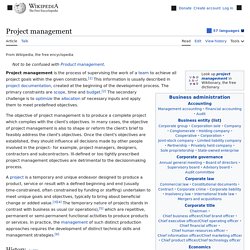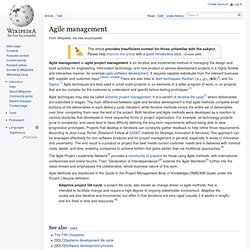

Waterfall model. The unmodified "waterfall model".

Progress flows from the top to the bottom, like a cascading waterfall. The waterfall model is a sequential design process, used in software development processes, in which progress is seen as flowing steadily downwards (like a waterfall) through the phases of Conception, Initiation, Analysis, Design, Construction, Testing, Production/Implementation and Maintenance. The waterfall development model originates in the manufacturing and construction industries: highly structured physical environments in which after-the-fact changes are prohibitively costly, if not impossible. Since no formal software development methodologies existed at the time, this hardware-oriented model was simply adapted for software development.[1] §History[edit] Project management. The objective of project management is to produce a complete project which complies with the client's objectives.

In many cases the objective of project management is also to shape or reform the client's brief to feasibly address the client's objectives. Once the client's objectives are clearly established they should influence all decisions made by other people involved in the project – for example project managers, designers, contractors and sub-contractors. Ill-defined or too tightly prescribed project management objectives are detrimental to decision making. History[edit] Henry Gantt (1861–1919), the father of planning and control techniques. Agile management. Agile management or agile project management is an iterative and incremental method of managing the design and build activities for engineering, information technology, and new product or service development projects in a highly flexible and interactive manner, for example agile software development.

It requires capable individuals from the relevant business, with supplier and customer input. [citation needed] There are also links to lean techniques, Kanban (かんばん(看板)?) And Six Sigma.[1] Agile techniques are best used in small-scale projects or on elements of a wider program of work, or on projects that are too complex for the customer to understand and specify before testing prototypes.[2]